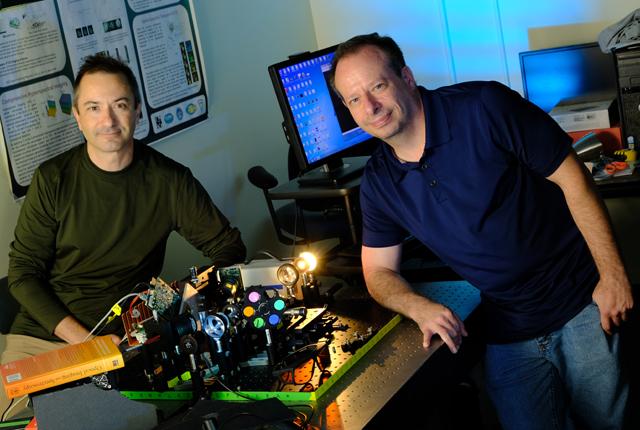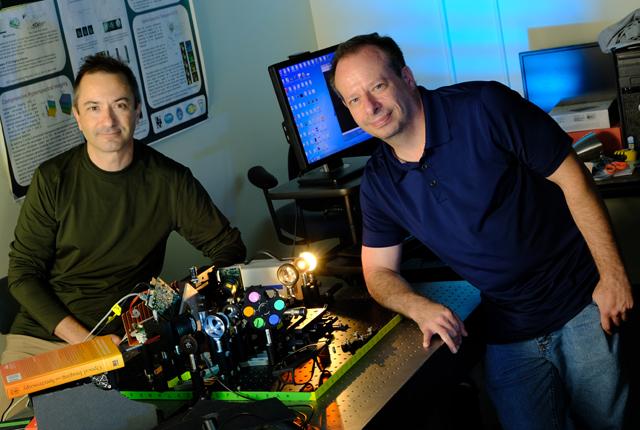
Credit: Jeff Fitlow/Rice University
Patients who have to undergo a magnetic resonance imaging scan may be spared the ordeal of having to lie still in the scanner for up to 45 minutes, thanks to new technology patented by Rice University, also known as "compressed sensing" technology.
The technology was recently licensed by Siemens Healthineers. MRI scanners equipped with the novel compressed sensing technologies operate much more quickly than MRI scanners currently in use. Siemens Healthineers applied compressed sensing technology to help solve a clinical problem: how to reduce long scan times while maintaining high diagnostic quality. The result is the first clinical application using compressed sensing technology for cardiovascular imaging and was approved for clinical use in February by the Food and Drug Administration.
Thanks to "compressed sensing" technology, which was developed in part at Rice, scans of the beating heart can be completed in as few as 25 seconds while the patient breathes freely. In contrast, in an MRI scanner equipped with conventional acceleration techniques, patients must lie still for four minutes or more and hold their breath for as many as seven to 12 times throughout a cardiovascular-related procedure.
In the future, compressed sensing might change the way MRIs of the abdomen are performed. Today, certain populations like pediatric patients or patients with labored breathing have to be excluded from having abdominal MRIs due to their inability to perform long, consecutive and exhausting breath-holds. With compressed sensing, the amount of data required for an image of excellent diagnostic quality may be reduced dramatically, potentially enabling free-breathing, contrast-enhanced imaging of the abdomen in one continuous run. This may allow clinicians to reliably perform abdominal MRIs on more patients with high reproducibility and consistency.
Richard Baraniuk, Rice's Victor E. Cameron Professor of Electrical and Computer Engineering, and Kevin Kelly, a Rice associate professor of electrical and computer engineering, are the pioneers of the compressed sensing technology licensed from the university for use in the scanner. Compressed sensing is a revolutionary branch of signal processing and optimization that enables engineers to glean useful information from far fewer data samples than would typically be required. Baraniuk and Kelly's initial research into compressed imaging led to the creation of the world's first single-pixel camera in 2006 as a proof of principle.
Last year, Siemens Healthineers rolled out compressed sensing-based MRI scanners. The technology radically increases sampling speed reducing overall scan time, with excellent resolution and image quality.
"MRI machines currently use mathematical technology developed in the 1930s, and scans can take up to 45 minutes and require patients to hold completely still during that time, something that is especially difficult for very sick or very young patients," Baraniuk said. "This technology will be a game-changer for MRI scanners, especially when it comes to serving patients whose age or health prevents them from holding their breath or being completely still for extended periods of time. The technology will also benefit cardiac patients. Previously, low diagnostic quality prevented these patient subsets from realizing any benefit from cardiac MRI, but the technology enables the entire cardiac cycle to be recorded in real time with only one breath-hold."
Kelly said Rice's compressive imaging technology has the potential to be commercialized for more than just MRI machines. For example, Kelly's lab is currently using compressive imaging in nonlinear optical microscopy. Thanks to its ability to process data quickly and produce usable images from fewer measurements, Baraniuk said, the technology could also potentially be used for radar or security purposes.
Baraniuk and Kelly call it a "big win" for Rice's technology transfer program.
"It's great to see an idea go from theory to practice in a way that makes life better for patients around the world," they said.
For more information on compressed sensing research at Rice, visit
http://www.ece.rice.edu/kelly.aspx and http://dsp.rice.edu.
-30-
This news release can be found online at http://news.rice.edu.
Follow Rice News and Media Relations via Twitter @RiceUNews.
Related materials:
Richard Baraniuk bio: http://richb.rice.edu/biography
Kevin Kelly bio: http://www.ece.rice.edu/kelly.aspx
Located on a 300-acre forested campus in Houston, Rice University is consistently ranked among the nation's top 20 universities by U.S. News & World Report. Rice has highly respected schools of Architecture, Business, Continuing Studies, Engineering, Humanities, Music, Natural Sciences and Social Sciences and is home to the Baker Institute for Public Policy. With 3,879 undergraduates and 2,861 graduate students, Rice's undergraduate student-to-faculty ratio is 6-to-1. Its residential college system builds close-knit communities and lifelong friendships, just one reason why Rice is ranked No. 1 for quality of life and for lots of race/class interaction and No. 2 for happiest students by the Princeton Review. Rice is also rated as a best value among private universities by Kiplinger's Personal Finance. To read "What they're saying about Rice," go to http://tinyurl.com/RiceUniversityoverview.
###
Media Contact
David Ruth
[email protected]
713-348-6327
@RiceUNews
http://news.rice.edu





